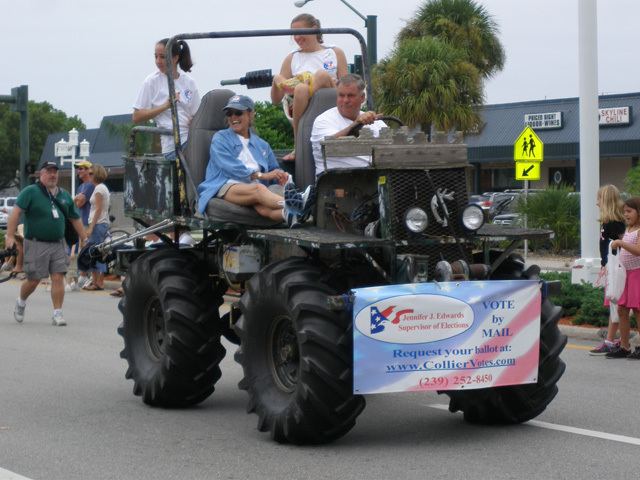 | ||
The swamp buggy is a motor vehicle used to traverse boggy swamp terrain. Swamp buggies may be purpose built, or vehicles modified to deal with the requirements to move around the swamp. All swamp buggies are able to move about on dry land, shallow mud, sand, shallow water and some times deep mud. Additionally they possess one or more of the following abilities:
Contents
Propel itself through or over deep mud and waterDrive through or over moderately dense vegetationDrive over rough terrain possibly including logs and stumpsFloat in water or mud (optional)History
Invented by Ed Frank, in Naples, Florida, the swamp buggy proved valuable during early development of the Everglades in the 1930s and 1940s. Aircraft tires from war surplus often found their way onto swamp buggies in the nineteen forties and fifties. Tractor tires commonly used in commercial agriculture became the norm during the nineteen eighties. The state of Florida commissioned the use of buggies by law enforcement as early as the 1930s.
The original swamp buggy, known as 'Tumble Bug', was a tall, ungainly and strange-looking vehicle, riding on huge balloon tires, which could be used for everything from hunting expeditions deep into the Everglades to Sunday afternoon outings. An editorial in the Collier County News, a local Naples newspaper, claimed swamp buggies were "as important to Florida as the cow pony is to the west, in that they are the only practical means of transportation once off the main road."
Types of swamp buggy
Though swamp buggy design varies greatly, there are two basic types. The 'Glades Buggy', originally a Model A frame with large rear tires, sits lower and resembles a jeep in build. The 'Palm Beach Buggy', a type developed in the northern Everglades in and around Palm Beach County, is a raised platform supported by four large wheels which sits quite high. Though these two types predominate, custom buggies sporting tank-like treads and smooth tires with snow chains were used in the past.
Swamp buggy racing
Swamp buggy racing is a popular pastime in Louisiana, Georgia, and Florida.
The early years
As more and more hunters built swamp buggies, they would gather together to share a few homespun-engineering tips, and before long, one hunter would challenge another to a race through a muddy bog on Raymond Bennett's potato farm, which, according to swamp buggy inventor Ed Frank, "was the biggest hole in the vicinity of Naples." The first organized races took place on Mr. Bennett's potato farm around 1943, featuring a dozen or so local hunters.
By the late 1940s, 31 to 41 racers would gather the week before hunting season to race for the valued prize, which was usually a new shotgun donated by a local merchant. On November 12, 1949, the first official Swamp Buggy Races were held, with a field of almost 50 competitors, in Naples, Florida. The mid 1950s saw continued growth of swamp buggy racing. ABC's Wide World of Sports featured the mud madness in a national television special and Hollywood stars like Gary Cooper were seen in Naples riding swamp buggies.
Mile O' Mud
The pp patch has now evolved into the Florida Sports Park and the once unruly bog has been groomed into the famed 'Mile O' Mud' it is as known today. The 'Mile O' Mud' is a seven-eighths of a mile (1.4 km) oval, featuring racing lanes which are approximately 60 feet (18 m) wide, with a one-eighth mile (200 m) diagonal lane slashed through the center. The depth of the mud is hard to gauge because brown swamp water covers every inch of the track, making it appear to be a foot (30 cm) deep, though it drops to between five and six feet (1.5 to 1.8 m) deep in three places. Buggies driving through these holes often disappear up to their steering wheels and exhaust pipes. The largest pit, located in front of the grandstand, is the treacherous 'Sippy Hole', named after 'Mississippi' Milton Morris, a legendary driver who could almost never conquer the hole without stalling.
Present day
As the popularity of the sport has continued to grow, cash prizes purses of several thousand dollars replaced the shotgun, and the incentives to go faster also grew, until the swamp buggies became far too fast and too loud to be used for hunting wild game. Today’s high-tech buggies are designed for racing only. The pontoon-like bodywork fully encloses a powerful racing engine, and rather than relying upon big fat flotation tires, they stand upon tall and skinny tires, with paddle treads on the rears designed solely for forward motivation and almost bicycle-narrow front tires for rudder-like steering.
There are three races a year, January, March, and October, and all three races are taped and televised by the Sunshine Network. The races have also nationally televised by the National Geographic Channel, TNN, ESPN and the Travel Channel. Before every October Race there is a 'Swamp Buggy Parade' in downtown Naples. Each of these events finds Naples pulling thousands of spectators from many states, and gives Naples and the swamp buggy sport extensive publicity.
Winners
1 - delayed from October due to Hurricane Wilma
